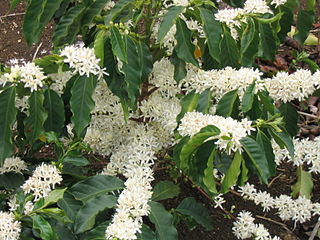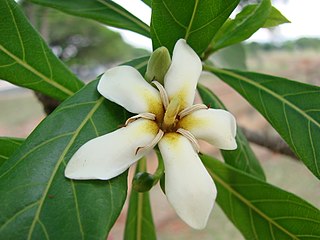
Coffea is a genus of flowering plants in the family Rubiaceae. Coffea species are shrubs or small trees native to tropical and southern Africa and tropical Asia. The seeds of some species, called coffee beans, are used to flavor various beverages and products. The fruits, like the seeds, contain a large amount of caffeine, and have a distinct sweet taste.

The Rubiaceae are a family of flowering plants, commonly known as the coffee, madder, or bedstraw family. It consists of terrestrial trees, shrubs, lianas, or herbs that are recognizable by simple, opposite leaves with interpetiolar stipules and sympetalous actinomorphic flowers. The family contains about 13,500 species in about 620 genera, which makes it the fourth-largest angiosperm family. Rubiaceae has a cosmopolitan distribution; however, the largest species diversity is concentrated in the tropics and subtropics. Economically important genera include Coffea, the source of coffee, Cinchona, the source of the antimalarial alkaloid quinine, ornamental cultivars, and historically some dye plants.

Genipa is a genus of trees in the family Rubiaceae. This genus is native to the American tropical forests.
Old World warblers are a large group of birds formerly grouped together in the bird family Sylviidae. They are not closely related to the New World warblers. The family held over 400 species in over 70 genera, and were the source of much taxonomic confusion. Two families were split out initially, the cisticolas into Cisticolidae and the kinglets into Regulidae. In the past ten years they have been the subject of much research and many species are now placed into other families, including the Acrocephalidae, Cettiidae, Phylloscopidae, and Megaluridae. In addition some species have been moved into existing families or have not yet had their placement fully resolved. A smaller number of warblers, together with some babblers formerly placed in the family Timaliidae and the parrotbills, are retained in a much smaller family Sylviidae.

Genipa americana is a species of trees in the family Rubiaceae. It is native to the tropical forests of North and South America, as well as the Caribbean.

The Adelidae or fairy longhorn moths are a family of monotrysian moths in the lepidopteran infraorder Heteroneura. The family was first described by Charles Théophile Bruand d'Uzelle in 1851. Most species have at least partially metallic patterns coloration and are diurnal, sometimes swarming around the tips of branches with an undulating flight. Others are crepuscular and have a drab coloration. Fairy longhorn moths have a wingspan of 4–28 millimeters, and males often have especially long antennae, 1–3 times as long as the forewing.

Xestia is a genus of noctuid moths. They are the type genus of the tribe Xestiini in subfamily Noctuinae, though some authors merge this tribe with the Noctuini. Species in this genus are commonly known as "clays", "darts" or "rustics", but such names are commonplace among Noctuidae. Xestia moths have a wide distribution, though they most prominently occur in the Holarctic.

Canthium is a genus of flowering plants in the family Rubiaceae. They are shrubs and small trees. The leaves are deciduous and the stems are usually thorny.

Casasia is a genus of flowering plants in the family Rubiaceae. These shrubs or small trees occur on the Caribbean islands and in one case in Florida. Some of the ten accepted species were formerly placed elsewhere, e.g. in the related genip-tree genus (Genipa), in Gardenia or in Randia.

Psydrax is a genus of flowering plants in the family Rubiaceae. It consists of trees, shrubs, and a few lianas in the paleotropics.

Pyrostria is a genus of dioecious flowering plants in the family Rubiaceae. Most of the species are endemic to Madagascar, others occur on islands in the western Indian Ocean, a few are found in continental Africa, and only six species occur in tropical Southeast Asia. The formerly recognized genus Leroya, containing two species endemic to Madagascar, L. madagascariensis and L. richardiae, was sunk into synonymy with Pyrostria.

Tricalysia is a genus of flowering plants in the family Rubiaceae. The genus is found in tropical and southern Africa and on the islands in the Western Indian Ocean.

Coffea liberica, commonly known as the Liberian coffee, is a species of flowering plant in the family Rubiaceae from which coffee is produced. It is native to western and central Africa from Liberia to Uganda and Angola, and has become naturalised in the Philippines, Indonesia, Seychelles, the Andaman & Nicobar Islands, and Malaysia.

The Nacophorini are one of the smaller tribes of geometer moths in the subfamily Ennominae. They are the most diverse Ennominae of Australia and are widespread in the Americas. If the African genera tentatively placed herein indeed belong here, the distribution of the Nacophorini is distinctly Gondwanan, with their probable origin either of Australia, South America or even Antarctica. In Eurasia, they are rare by comparison.

The Maleae are the apple tribe in the rose family, Rosaceae. The group includes a number of plants bearing commercially important fruits, such as apples and pears, while others are cultivated as ornamentals. Older taxonomies separated some of this group as tribe Crataegeae, as the Cydonia group, or some genera were placed in family Quillajaceae.
Bremeria is a genus of flowering plants in the family Rubiaceae. It was described in 2005 to accommodate all the Indian Ocean species formerly placed in Mussaenda, except the widespread Mussaenda arcuata. The genus is indigenous to Madagascar, Mauritius and Réunion, and is found in humid to subhumid evergreen forests.
Coptosperma is a genus of flowering plants in the family Rubiaceae. It contains 19 species native to Africa, the Arabian Peninsula, and various islands of the Indian Ocean.

Ixoroideae is a subfamily of flowering plants in the family Rubiaceae and contains about 4000 species in 27 tribes.

Gardenieae is a tribe of flowering plants in the family Rubiaceae and contains about 586 species in 53 genera.
















